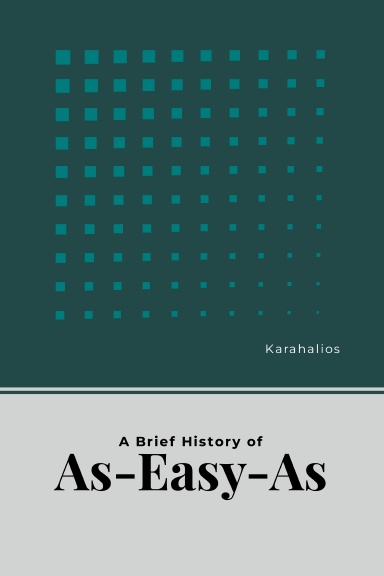 A Brief History of As-Easy-As
A Brief History of As-Easy-As
A first-person history of a standout shareware spreadsheet application.
In 1990, entered the undergraduate physics program at the University of Wisconsin-River Falls. Our physics department had a very strong lab program; every semester, we physics students performed experiments that exercised concepts we learned in the classroom.
The professor who designed the lab program made sure we understood the error inherent in taking measurements. Every experiment required us to do an analysis of uncertainties of our measurements, a grinding process we called “error analysis.” In theory, you can calculate the mean and standard deviation of a measurement by hand, but it’s hard work. It really calls for a computer to do it. And that’s where As-Easy-As really stood out.
As easy as 1. 2. 3.
As-Easy-As was an example of shareware, a new way to sell software. Instead of purchasing an expensive “boxed” application from a computer store, you could download a copy of a shareware program from a dial-up bulletin board system. I also subscribed to a catalog that listed the best shareware applications and games; for a few dollars, they would mail you a floppy disk with the shareware programs you wanted to try. That’s probably where I found As-Easy-As.
For only $69, I had a powerful spreadsheet application that let me do all of my lab analysis from the DOS computer in my dorm room. And it was easy to use.
With As-Easy-As, I could quickly calculate the values (with uncertainties) for each of my labs, including linear regression. When I was done with my analysis, I could print out tables and graphs to my Epson FX-80 dot matrix printer.
I think I bought every new version of As-Easy-As from then until version 5.7, the last release of the of the DOS version, released in 1997. I used it for everything. Dave and Paris created a rare thing: a program that I love to use.
A great interview
I found Paris Karahalios on LinkedIn. Paris was the co-creator of As-Easy-As, so I reached out to ask if I could interview him for an article I wanted to write about the spreadsheet.
I find that most people will write about 800 words in an interview, no matter how many questions you ask. If you ask four questions, they’ll write long answers for a total of about 800 words. If you ask ten questions, they’ll write shorter answers for about 800 words.
Paris wrote a lot more than that. And he provided a ton of technical detail about how he and Dave Schulz created the prototype for As-Easy-As, based on a sample “spreadsheet”-like program in Borland TurboPascal. Paris also described how they continued to add features to the prototype until it had parity with other spreadsheets like Lotus 1-2-3.
And I was surprised that Paris volunteered to write more. I sent several follow-up questions, and Paris shared more details about how they grew TRIUS Inc as the company behind As-Easy-As, his technical background, and how they wrote the manual. He also shared a collection of photos, articles, and letters about As-Easy-As.
A brief history
I wanted to share Paris’s story, so others could read the whole thing. I collected everything Paris sent me—every interview answer, every photo, every story—into a book. This is a brief history of As-Easy-As, but it’s also a demonstration of why As-Easy-As was my favorite spreadsheet, and still is.
I hope this history shows why I loved As-Easy-As, and maybe you might like to use it too.
- Download the free ebook (PDF)
- Buy a print copy (112 pages)

Paris Karahalios. Jim Hall (ed.). (2025) A Brief History of As-Easy-As. Technically We Write. Published under the Creative Commons Attribution ShareAlike license.
